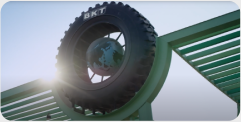What should you do if a tire of your tractor goes flat? Find out with our tips!
Everyone has been in this sort of situation: a tire of your tractor is damaged or goes flat. Really annoying, but things like this happen... yet, tires face challenging situations with heavy loads on tough terrains every day, not forgetting debris, roots or other foreign matters that might cause punctures.
Whatever the reason, once a tire goes flat, it’s anything but changing a car tire – if only it were a piece of cake!
The first thing to do in these cases: stop as soon as you realize what has happened. Driving on with a damaged or flat tire may cause serious damages to the rim or the vehicle structure.
Having assessed the situation and identified the causes, organize the replacement. Remember to contact your local tire dealer as both mounting and dismounting farming tires are hazardous operations. These must be performed by expert and qualified staff members only, using appropriate tools and procedures, as to the instructions of the faming machinery manufacturer, in order to avoid structural damages and to ensure the operator’s safety.

How does the tire specialist do the job?
When changing a tire, there are several steps to follow: preparation, inspection, mounting and final check. Let us have a closer look at the single steps.
Preparation
Before fitting the tire on the rim, the following requirements are to be met:
- Tire size and features must be suitable for the vehicle and the job to be done.
- The rim size must be suitable for the tire. The manufacturer specifies the rim size to be used for the specific tire.
When doing the job, it is recommended to always refer to the instructions and procedures indicated by the rim, tire, and vehicle manufacturers, and to use appropriate tools and equipment in good condition only.
Inspection
At this stage, both the rim and the tire to be mounted are checked:
- Rim: After having checked the rim conditions, it is properly cleaned using a metal brush. Rims with weld joints, or visibly deformed or damaged rims should never be used.
- Tire: The tire bead must be cleaned and without any elements that might cause an air leak. A compressor is used to clean and dry the inner part of the tire and a dry cloth to clean the external surface. Never use solvents: they are your tires’ enemy!
Mounting
Here we go and see how a tire is mounted on the rim:
- The rim is placed on the mounting device.
- It must be checked that the inflation valve functions properly. It is recommended to always use new vales at every mounting.
- Rim and bead are lubricated with specific products for tire mounting only. A soft-bristled brush is used to spread the lubricant over the surface. Silicon or other solvent-based substances shall never be used.
- The tire bead is placed on the rim channel. It is important to make sure that at least part of the tire bead stays within the rim profile.
- The tire remains in position due to its weight and the ground contact during rim rotation.
- Rotating the tire, the bead is gradually positioned on the rim.
- The rotation is completed until the entire bead is positioned on the rim.
Final Check
This last step is very important:
- Check that both tire beads are correctly positioned on the rim.
- Adjust the tire pressure according to manufacturer recommendations and the intended operating conditions.
Well, a flat tire or other tire damages are a real nuisance causing downtime and unexpected costs. In order to possibly avoid these occurrences, our recommendation is to treat your agricultural tires with great care. You’d like to know how? Here you can read about some precautions and hints to keep you tires in a fit state as long as possible.





